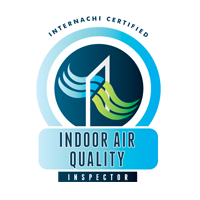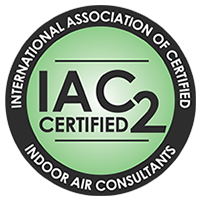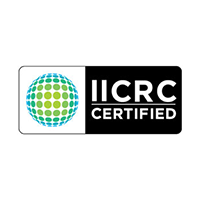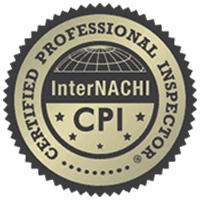Frequently asked questions.
Frequently asked questions.
Air quality testing is an important topic for many people. Whether you are a landlord, a business owner, or a resident – there are many aspects to consider when it comes to this type of testing. In most cases, it is best to hire a professional to come out and perform the inspection, but there are also some things that you can do on your own. To help you understand the basics of air quality testing, we have compiled some frequently asked questions and answers below:
There are a few factors that determine the price of professional air quality testing. Depending of air quality testing type, how fast you need the results and location of your property you may have a different final quote.
Contacting professionally trained, certified, and experienced air quality consultants will make sure you will identify the exact sources of potential health risks in your home or office.
Air quality testing is a procedure of taking air samples from an indoor environment. The results of air quality testing give you an overview of elevated air pollutant levels in your home or office space.
Air quality testing is done by taking a sample of air and analyzing it for concentrations of certain chemical compounds. This will be done in a laboratory to ensure accuracy, and the sample is analyzed using gas-chromatography or mass spectrometry.
There is no specific, regulated schedule for checking air quality. It is recommended that you check the air quality in your home every 2-3 months.
The signs of poor air quality are many, but the most common ones are increased breathing difficulty, coughing, respiratory infections, and asthma symptoms. In addition to those symptoms, exposure to fine particulates from smoke or dust can lead to elevated risk for chronic lung diseases such as emphysema and bronchitis.
Mold is a type of fungus that requires warm, moist environments to grow. Mold spores can spread via air and may enter your home through open windows and doors as well as leaky pipes. A musty or earthy odor may also be an indication that mold is present; if you detect this smell, you should take care not to walk inside the area until the problem has been remedied.
If you find mold in your home, you should contact a professional. Mold is often found in kitchens and basements, but it can also grow in other areas like bathrooms or any room with high humidity. Mold can be very dangerous for people who are sensitive to spores, so professionals need to identify the species of mold before starting any treatments. Once you have identified the type of mold, the professional will come up with an appropriate course of action that’s best for that particular species.
The signs of asbestos exposure typically include:
- Difficulty breathing
- Coughing up blood
- Chest pain or tightness
- Nausea and vomiting
- Frequent lung infections
- Loss of appetite and weight loss
If an individual is exposed to asbestos, they should immediately exit the area where they were exposed. They should not touch their mouth or eyes, so health care professionals can properly dress the area. An individual should also wash their hands thoroughly after being exposed to asbestos.
The purpose of an odour inspection is to ascertain whether or not the building has any gas leakages, or smells that may be emanating from within. A qualified inspector will use specially designed instruments to detect the presence of gas vapours and other potentially hazardous substances, as well as their origins. This information can then be used to determine what, if any, actions need to be taken by the building’s occupants.
Odors are the smells that people and animals perceive and react to. The most common odors that people and animals will respond to are those that alert them to the presence of danger, such as fire or gas leaks. More subtle responses may be conditioned by social upbringings, such as the smell of coffee which is considered a pleasant smell for many people.
Volatile organic compounds are organic chemical compounds that have a low boiling point and therefore vaporize easily.
VOCs are emitted from many sources, such as paint, solvents, cleaning agents, sewer gas, and motor vehicles.
In the atmosphere of a room with no air circulation, VOCs can lead to eye irritation and respiratory problems. Some people may be more susceptible than others due to their genetic makeup.
Air quality tests are worth it for a variety of reasons. They help identify the sources of pollutants in the air, which can then be corrected or avoided.
Polluted air is linked to numerous health problems, including asthma and respiratory conditions.
There are many different types of pollutants that may be tested for on a regular basis, such as particulate matter, ozone, and sulfur dioxide.
We know if our indoor air quality is bad in many ways. One way is by the presence of odors. The most common odors that signify poor indoor air quality are cooking smells, musty odours, cigarette smoke, and pet odor. Another way to know if our air is bad is to have health symptoms of poor air quality-dry eyes, dry mouth, sore throat, scratchy voice, headaches, itchy skin, allergies, irritability.
Professional air quality testing, also known as “air quality management” is a service that provides people with the knowledge and skills to effectively assess and manage their indoor air.
Professional air quality testing, which encompasses a wide range of disciplines, is typically conducted by a certified technician.
There are many different types of tests that can be done including particulate counts, carbon dioxide level, mold assessments, volatile organic compound (VOCs) levels, and more.
The cost will vary depending on factors such as the type of equipment, location, and number of samples that need to be taken.
Air quality is the measure of the harmful pollutants in the air, such as sulfur dioxide, ozone, and particulate matter. These pollutants have an adverse impact on human health and have been linked to a number of diseases including asthma, lung cancer, and bronchitis.
How often one should test their air quality depends on the specific environment of one’s home. Generally, it is recommended that people do so at least once per year. This can be done by having an indoor air quality test done by a professional company.
A variety of methods are used for testing air quality. These methods include, but are not limited to, gravimetric analysis, chemiluminescent analysis, colorimeter sensitive analyses, electrochemical analyses and particulate matter (PM) analysing techniques such as sector-field ICP-AES or inductively coupled plasma-mass spectrometry (ICP-MS).
Indoor air quality is affected by many pollutants, including chemical compounds that are natural, such as radon. One of the most important sources of indoor air pollution is moisture; the high humidity that accompanies a house during cold months can cause mold or bacteria to grow on surfaces that have succumbed to mildew and mites. This causes poor indoor air quality. Tobacco smoke contains carbon monoxide and nicotine, both of which can be hazardous to health, especially for those who suffer from asthma.
Air quality testing: The air quality of a certain area is tested by collecting and analyzing the concentration of pollutants in the area. This includes the following:
– Pollutants that can be seen such as smog or dust
– Pollutants that cannot be seen such as chemicals and microbes
Air quality monitoring: The air quality of a certain area is monitored by collecting and analyzing the concentration of pollutants in the area over time.
The air quality in the home should be tested at minimum once annually, but ideally twice or more annually. The best time to test is before major changes like painting, having the carpets professionally cleaned, or doing any other work. This will provide a baseline measurement of what the indoor air is normally like and measure any significant change from it. In doing so, one can detect abnormal changes in indoor air quality.
Air quality testing is a process that consists of collecting and analyzing samples from the air. The volume of particles that are collected in these samples will be quantified and categorized to determine whether the level of pollution exceeds acceptable levels. Such particles can include smoke, dust, and pollen among others. These particles can come from many sources such as vehicle exhaust or construction sites.
A particle is an object which can be seen by the naked eye, for example, the tiny specks in the sky following a fireworks show. A gas is any substance that can’t be seen with the naked eye and occupies space or has molecules in it. The particles are made of atoms which are themselves made up of electrons, protons, and neutrons; while gases are made up of molecules, which are composed of atoms.
A smell is any sensation that stimulates the olfactory epithelium, whereas a bad smell is any smell that causes nausea, dizziness, or other negative sensory responses. A good smell stimulates the olfactory epithelium with sensations such as flowers and spices.
The most common way to prevent bad smells in the home is by using containers which air can flow through. This allows for the release of odors without any potential for them to build up.
A second option is to use an exhaust fan or vent which will remove any bad air that builds up inside.
A third option would be to make sure you are regularly cleaning your home, including the trash cans and kitchen sinks.
The cost of an air quality test service can vary depending on a few factors. The type of equipment used, the location of the testing, and whether any additional tests are included in the fee, such as mold or chemical screenings, all affect the final cost per unit.
The cost-effectiveness of air quality tests depends on several factors, such as the size and layout of your house. For those with pets, the presence of animals will often trigger false positives from CO2 detectors. In smaller homes, it may be unnecessary to test for mold and other substances, but in larger dwellings air quality should be inspected and monitored regularly.
Home testing for air quality is not as accurate as professional testing, but it’s simple to do. For example, you could buy a DIY carbon monoxide detector at your local hardware store, or buy an indoor air quality monitor online. Simply set up the detector or monitor in your home to measure levels of pollutants.
The accuracy of home air quality tests is dependent on the device being used to conduct the test, as well as the person conducting the test. The accuracy is also dependent on a number of factors including humidity, temperature, and air pressure. If a home air quality test is conducted in an unconditioned environment or if it was not performed correctly then it can lead to false results.
The symptoms of bad air quality in the home are often lacking fresh air, consistent dust, pet dander, allergens, and odors. The first sign of poor air quality is usually sneezing or coughing. Allergic reactions can also occur with exposure to pollen or dust mites. Asthma attacks may happen when exposure to allergens occurs for someone who suffers from asthma.
Some people claim that air quality tests are not worth the effort. Air quality tests help people to avoid health problems and keep their environment clean. Air quality testing is a low-cost and low-effort way to make sure the air we breathe is healthy.
Air quality testing in the home is not a standard home maintenance item. Prices for this service vary depending on the number of samples necessary, the type of sample, and the type of test performed.
We are all well aware of the environmental issues our world faces. It is becoming more apparent that even though these issues are getting worse, they are not being addressed properly. We need to do something about this problem, but what? One way is to measure the quality of air in our homes or neighborhoods for ourselves. The EPA provides recommendations on what you should be measuring and how often it should be done. They recommend that you perform measurements at least once a month.
When an individual is exposed to poor indoor air quality, they may experience one or more of the following: increased respiratory problems such as asthma, throat irritation, and chronic cough, impaired lung function and general health issues such as reduced quality of life.
Air quality testing is beneficial because it is an efficient way to manage the air people are breathing. Air quality testing can identify harmful substances that are present in the atmosphere. The most important benefit of air quality testing is that it helps prevent harm to people’s health.
Indoor air quality testing uses state of the art equipment and laboratory analysis to detect mold spores, bacteria, asbestos, and other contaminants in the air.
Our indoor air quality testing cost is dependent on the type of testing, and the volume of the space that we are testing. Contact Us for a free evaluation and quote for your test.
Our inspectors and laboratories are certified to detect mold, bacteria like legionella asbestos, metals, and hazardous waste in the air.
Indoor air quality testing is testing the air for any number of allergens, irritants or gasses. The test is performed by a trained professional using various pieces of specialized equipment and devices to detect the various contaminants.
This is a difficult question to answer as every testing situation is different depending on what is needed. The best thing to do is contact the Air Quality Testing Belleville professional in your area and have a free quote provided to you on exactly what would be performed on your premises.
Air quality testing can detect elevated levels of various indoor air pollutants. These pollutants can include mold spores, asbestos fibers, various gasses like radon, carbon monoxide as well as other less common gasses like formaldehyde. Air quality testing can also test for rodent infestation, dust issues and various other contaminants.
For a full spectrum of services that we provide at Air Quality Testing, contact our trained professional in your area to discuss what you require, and we will provide a customized solution for your dwelling.
As each situation is different, the time it takes to complete the testing is different. A simple one room test would be much shorter than a full building sampling that needs every room tested for contaminants.
In much the same way that it is hard to tell a customer how long it will take to provide the testing services, it is equally or more difficult to provide a cost to the customer without having a visual inspection completed. As each situation is different the methods used will be different. From simple surface samples to air sampling of every space will change the cost of the testing dramatically. If we need to use infrared cameras to locate the problem, the cost will rise again. However, using every piece of equipment may not be necessary to locate the issue. That is where our years of experience and training come in to play an important part of the cost process. We do what is necessary to remedy your mold issues.
Seeing that every DIY test kit is different, using them is not an ideal way for you to find out if you have a hidden mold issue. The only reliable and accurate way to know what is happening inside your dwelling is to have a professional properly test for mold using proven methods and equipment. The professionals at Air Quality Testing are fully trained and have years of experience to provide you with the best service, knowledge and results.
If you think you have a mold issue inside your dwelling, whether it is in your home or workplace, having your testing done as soon as possible is essential in stopping the spread of mold. Waiting will cause more spread and damage to the premises and in turn create more expense in testing and remediation. Contacting Air Quality Testing right away will be the most cost-effective way to remediate the mold issues if there are any.
The answer to this question depends entirely on the scope of work. Testing one area will be cheaper than testing an entire structure. Most times testing an entire structure is needed to provide the accurate and correct view of what is going on in the structure. Using Air Quality Testing provides the best cost per benefit for your testing needs.
Asbestos is a very light fiber material. It is woven into various building products as well as other items like car brake pads to provide strength and heat resistance to these materials. It is very small and will hang in the air of the structure for periods of time where it can be inhaled by humans. Doing an air quality test for asbestos is essential to see if there is any in the air. A sample cartridge is hooked up to an air pump. This pump draws in air from the area being tested for a certain amount of time and at a pre-determined rate.
After the sample is complete, it’s sealed and sent to an independent laboratory for analysis. The report is provided with full detail of what is in the air and then provided to the client that hired Air Quality Testing.
Having your structure tested for asbestos is determined by the age of the dwelling. If it was built before 1990, and you are doing any sort of renovation you will need to have a test completed on the affected area. This will ensure you do not contaminate other areas inside the building and that you are safe when removing the old building materials when doing demolition. Contacting Air Quality Testing will give you piece of mind before you start that you are safe from inhalation of asbestos.
As mentioned earlier, the scope of testing will determine how long the testing of areas will take. It may be that you only need one sample taken in one room. It could be you are doing a multi-level apartment building renovation where many samples will need to be completed. It all depends on the scope of work being completed. Once the samples are taken and sent to the laboratory, the turnaround time for results are quite quick, requiring 48 hours for the laboratory to get their results. This again depends on the scope of work. Contacting Air Quality Testing to do an inspection is the best way to get an accurate timeline of what is needed.
Volatile organic compounds (VOCs) refer to chemical compounds emitted from motor vehicles, paint, and several other sources. Without proper air circulation, VOCs can cause respiratory problems and eye irritation.
You should schedule air quality testing in Montreal if you notice any of the following:
- Strange odours in your home or building
- Respiratory symptoms that last longer than two weeks
In addition, you should schedule air quality testing for asbestos and mould if you plan to purchase or sell a new home, break a lease, or need to settle a legal dispute involving health conditions in the workplace.
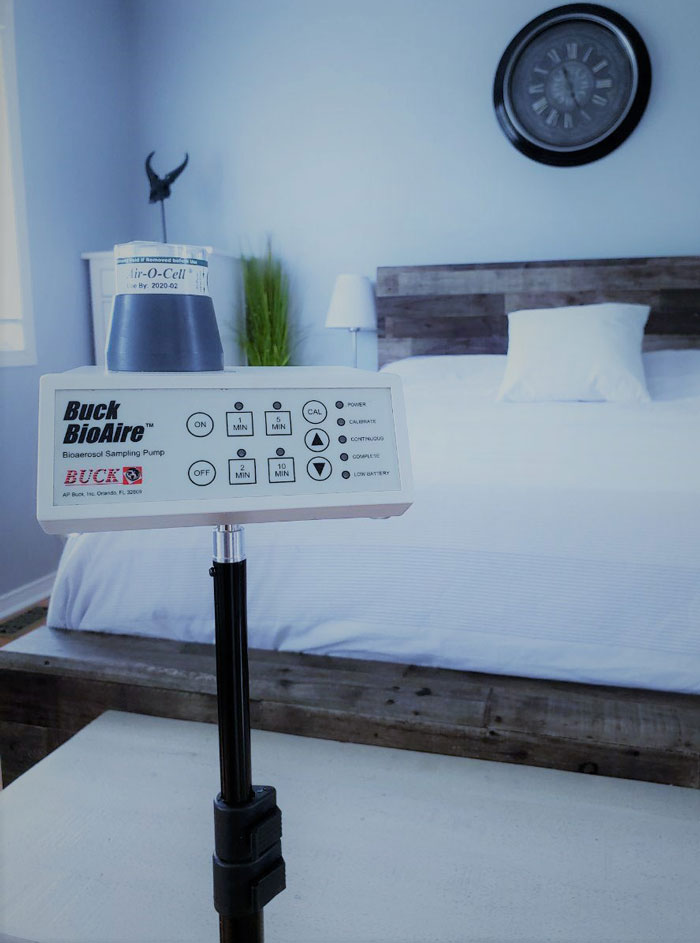
Our certifications
